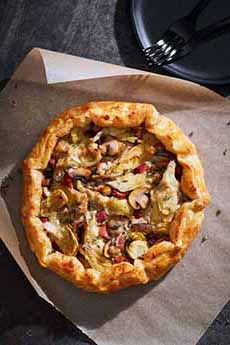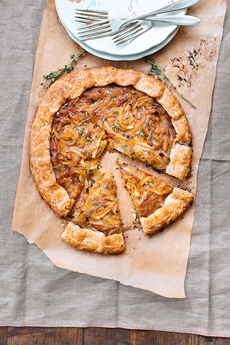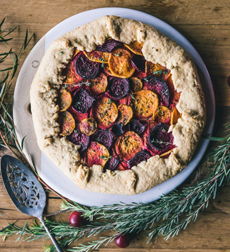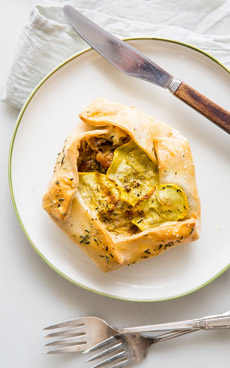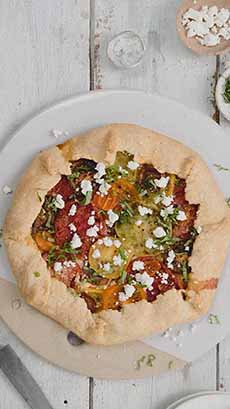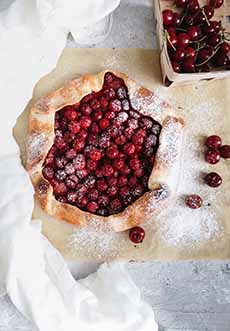TIP OF THE DAY: Make A Galette For Brunch, Lunch Or Dinner
|
A yummy winter galette recipe is below. You can serve it at brunch, lunch or dinner. But first, some words about galettes (the term in Italian is crostata). Galette (from the Norman word gale, meaning “flat cake“) is a French term for a flat pastry, usually round—i.e., a rustic pie. The filling can be sweet or savory. Galettes preceded pies. Before pie pans became available and affordable, cooks would roll out a large circle of dough, placing the filling in the center. A large border of dough remained to fold up, the folded crust creating a border that keeps the filling in place. There was and is only a bottom crust. While the aim was to create a round shape, galettes could be less than a perfect circle but more free-form. Modern galettes often use puff pastry as the base; but can also be made from a yeast dough like brioche, or a sweet pastry crust. Different regions make pastries called “galette” that are different in concept; for example: We’ve just defined a galette: a free-form single-crust flat filled pastry made without a pie pan. Here’s how it differs from a: Here’s the difference between pies and tarts. This recipe is a “winter galette” because it uses vegetables that are easily available in the cold weather months: artichoke hearts, leeks and portabello mushrooms. With lots of vegetables, salty parmesan cheese and a flaky crust, you can serve it for brunch, as a light lunch with a salad, as a bite with wine or cocktails, or as a first course at dinner. Thanks to DeLallo for the recipe. 1. PREHEAT the oven to 375°F. Heat a large skillet over medium heat. Add the onion, bay leaf and salt and cook gently until the onion is soft and aromatic, about 10 minutes. 2. ADD the leeks and cook, stirring, for three more minutes. Then add the pancetta, garlic, mushrooms and thyme. Cook for 5 more minutes. 3. ADD the wine and allow the mixture to simmer for 3 minutes. Then add the stock and simmer for another 3 minutes to reduce the mixture. Stir in the artichokes and simmer for 10 minutes. Meanwhile… 4. MAKE a roux by melting the butter in a separate pan over medium-low heat. Add the flour and stir constantly for 3-5 minutes, until the mixture thickens. Add the roux to the artichoke mixture and cook for another 3-5 minutes, until it thickens slightly. 5. REMOVE the skillet from the heat and stir in the ricotta and parmesan. Set aside to cool slightly. 6. TAKE the puff pastry from the refrigerator. Flour your work surface and roll the dough to about 1/8-inch thick. Cut into a 9” circle or keep rectangular. Transfer to a baking sheet lined with parchment paper. 7. TOP the dough with the artichoke mixture, leaving a 3-inch border around the edges. Fold the edges of the dough over the filling. Brush the crust with the beaten egg. 8. BAKE the galette for 45-55 minutes or until the crust is golden. Allow it to cool for 5 minutes, then slice and serve. |
|
|
|
> THE DIFFERENCES BETWEEN PIES & TARTS > THE DIFFERENT TYPES OF PIE & PASTRY *We used plain canned artichoke hearts not soaked in marinade. †For a pancetta substitute, consider Canadian bacon, prosciutto, smoked ham or smoked sausage. For a vegetarian alternative, olives or cubes of portabello mushrooms are often substituted. Since the recipe already has portabellos, you can add more of them. Also consider chickpeas and Textured Vegetable Protein. ‡You can substitute yellow onions. Yellow onions are preferred for caramelizing, which draws out their natural sweetness. White onions are slightly sweeter, a bit milder in taste than yellow onions and can be used raw with salads and sandwiches. White onions shouldn’t be confused with sweet onions such as Maui and Vidalia. While these sweet onions are also white, sweet onions have a much higher sugar content and a lower sulfur content. The sulfur content creates the pungency in onions.
|
||
